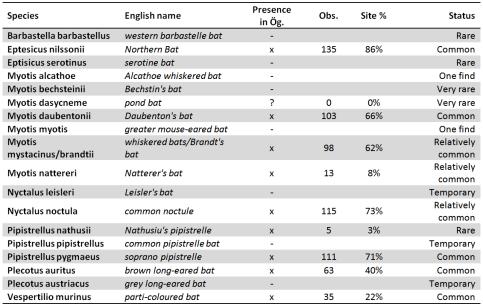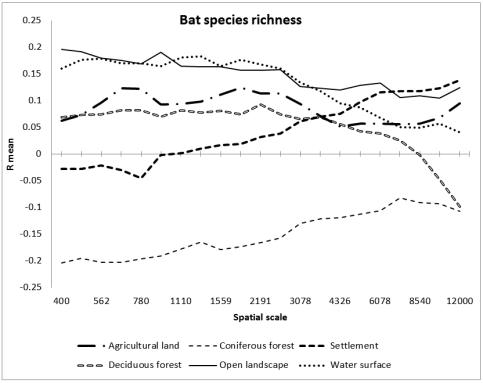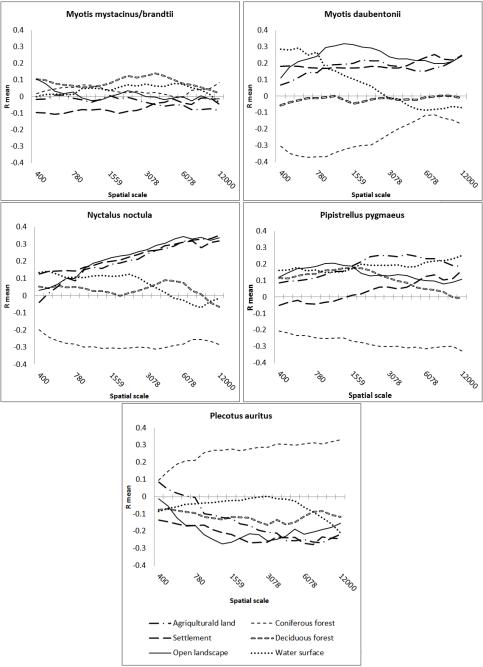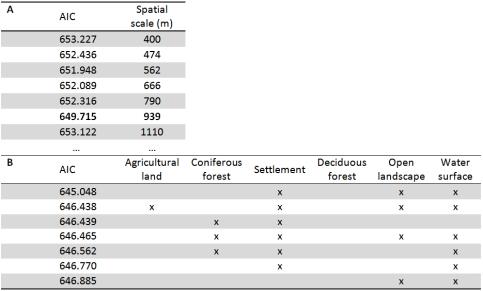Bat species list

List of the Swedish bat species with their scientific and common English name. In the column “Presence in Ög” (Ög=Östergötland) every species mark with an “x” has been observed in Östergötland and the other with an “-“ have not been found here before. It is unclear if the pond bat (Myotis dasycneme) should count to the bat fauna of Östergötland. It has only been speculations and suspicious recordings of it but no clear observation exists. “Obs.” Is the number of observation of this species used in this study between the years 1994-2012. “Site%” is the observance percentages value of the species in all the 156 sites. “Status” is the Swedish species status, accordingto Länsstyrelsen, Östergötland
Bat species richness

Overall bat species richness responded positive over all scales to increasing area of Water surface, Open landscape, Deciduous forest (up to 8540m radius, after that they responds to it negatively) and Agriculture land, and showed a negative response to increasing Coniferous forest. Bats responded negative on Settlements in the local scale and a positive response in the regional scale. The bat species richness response was quite constant on Water surface, Open landscape, Deciduous forest and Agriculture land up to 2km, Although the bats response on Agriculture land had a peak response on 780 and 1848m. The reason for positive response for bat species richness of Water surface, Open landscape, Deciduous forest and Agriculture land may be that they respond to the insect concentration within the landscape (de Jong et al. 1991). Since water bodies offers higher densities of insects.
X-axis is the mean values from the focus software’s linear regressions and y-axis different amount of habitats at different spatial scales.
Individual specie response

For the five most commonly observed species (except E. nilssonii that had a to great observation rate with observation in 86% of the sites) in this study, there were huge differences among the species.
Myotis mystacinus and M. brandtii did show overall a very low response to all the different habitat types across all scales compared to the other species. This could be because that they actually are two species that is counted as one because of difficulties in separating them acoustically. This low response could be that they are wipeing-out each others response, expiate that they have very similar foraging habitat.
Myotis daubentonii habitat variables are not as tight together as P. pygmaeus’s are. However, it is showing a stronger response overall (R mean <0.32) compared to P. pygmaeus (R mean <0.25). My result indicates that M. daubentonii show a very strong response to water due to that they often can be observed hunting just centimeter over the water surface.
Nyctalus noctula is the largest bat in Sweden, it can forage in almost every type of landscape due to its hunting behavior. This bat has its hunting grounds high above the tree-canopy, locating insects far away with miner environmental disturbance and catches them in fast flight. According to my results, this particular bat responds locally (<780m radii) to water surface and deciduous forest. However, it may have a stronger response to the landscape characteristics on a more regional scale (>1559m radii), particular to Open landscape, Agriculture land and Deciduous forest.
Pipistrellus pygmaeus is an agile bat that can hunt in a limited area, such as within the canopy of trees or under branches overhanging water in almost all forest types. Pipistrellus pygmaeus did not show so very great response towards the different habitat variables except towards agriculture in the regional scale (>4326m radius, R mean: 0.26). in the local scale (<1559m) it shows about the same response regardless of habitat (except coniferous forest and settlement), which will seem like this particular bat do not have specific local habitats criteria and instead react on a regional scale.
Plecotus auritus that has the most astonishing response, this bat showed a positive response to increasing coniferous forest while all the other bat showed a more or less negative response (except from M. mystacinus/brandtii), and it had a negative response on almost all the other habitat variables.Plecotus auritus spend most of its time in self-sown coniferous forest but also in mixed woodland and mature deciduous woodlands, and all feeding sites was associated with either woodland of some sort or individual trees.
AIC

AIC showed however that the bat species richness responded the strongest at a radius of 939m (2.039 lower than the next one) and at this scale; Settlement, Open landscape and Water surface was the factors that best could explain the bat species richness in the landscape (1.39 lower than the second). Species like P. auritus and E. nilssonii that usually does not move more than 1 km between their roost and their foraging grounds, have their roost most likely within this “common species response” (<939 km) radius. Other species like the Myotis spp, that can have a distance from 2.8 up to 10km from their roost to their foraging ground (depending on species), can have their roost outside of the “common species response”. However, Gorresen et al. (2005) have shown that bat abundance responds to landscape characteristics as large as 5 km radius, and de Jong et al. (1991) states that “it is common that bats fly several km between their roost and hunting grounds”
“A”. The scale that had the lowest AIC values when compared the different scale.
“B”. Lowest AIC values for the best habitat combination at the spatial scale of 939m that had the lowest AIC values in A.
Referens
Gorresen PM, Willing M, & Strauss R (2005) MULTIVARIATE ANALYSIS OF SCALE-DEPENDENT ASSOCIATIONS BETWEEN BATS AND LANDSCAPE STRUCTURE. Ecological Applications, 15(6), 2005, pp. 2126-2136
de Jong. J (1961) Fladdermössen i landskapet : biologisk mångfald och vareation i odlingslandskapet. Jönköping : Statens jordbruksverk : Skogsstyr., 2000.
Responsible for this page:
Director of undergraduate studies Biology
Last updated:
05/06/13
